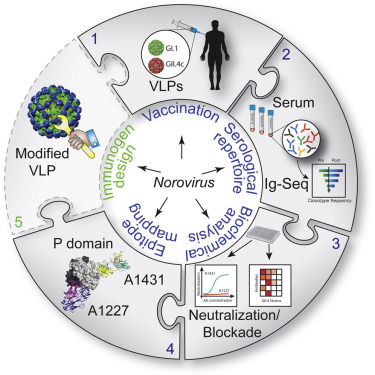Immunity ( IF 25.5 ) Pub Date : 2019-06-18 , DOI: 10.1016/j.immuni.2019.05.007 Lisa C Lindesmith 1 , Jonathan R McDaniel 2 , Anita Changela 3 , Raffaello Verardi 3 , Scott A Kerr 4 , Veronica Costantini 5 , Paul D Brewer-Jensen 1 , Michael L Mallory 1 , William N Voss 2 , Daniel R Boutz 4 , John J Blazeck 2 , Gregory C Ippolito 6 , Jan Vinje 5 , Peter D Kwong 3 , George Georgiou 7 , Ralph S Baric 1

|
Rapidly evolving RNA viruses, such as the GII.4 strain of human norovirus (HuNoV), and their vaccines elicit complex serological responses associated with previous exposure. Specific correlates of protection, moreover, remain poorly understood. Here, we report the GII.4-serological antibody repertoire—pre- and post-vaccination—and select several antibody clonotypes for epitope and structural analysis. The humoral response was dominated by GII.4-specific antibodies that blocked ancestral strains or by antibodies that bound to divergent genotypes and did not block viral-entry-ligand interactions. However, one antibody, A1431, showed broad blockade toward tested GII.4 strains and neutralized the pandemic GII.P16-GII.4 Sydney strain. Structural mapping revealed conserved epitopes, which were occluded on the virion or partially exposed, allowing for broad blockade with neutralizing activity. Overall, our results provide high-resolution molecular information on humoral immune responses after HuNoV vaccination and demonstrate that infection-derived and vaccine-elicited antibodies can exhibit broad blockade and neutralization against this prevalent human pathogen.
中文翻译:

血清抗体库分析揭示了人类诺如病毒疫苗接种后广泛和大流行菌株中和反应的机制
快速进化的 RNA 病毒,例如人类诺如病毒 (HuNoV) 的 GII.4 株及其疫苗会引发与先前接触相关的复杂血清学反应。此外,保护的具体相关性仍然知之甚少。在这里,我们报告了 GII.4 血清学抗体库——接种前和接种后——并选择了几种抗体克隆型进行表位和结构分析。体液反应由阻断祖先菌株的 GII.4 特异性抗体或与不同基因型结合但不阻断病毒-进入-配体相互作用的抗体主导。然而,一种抗体 A1431 对测试的 GII.4 菌株显示出广泛的阻断作用,并中和了大流行的 GII.P16-GII.4 悉尼菌株。结构映射揭示了保守的表位,它们被封闭在病毒粒子上或部分暴露,允许具有中和活性的广泛封锁。总体而言,我们的结果提供了有关 HuNoV 疫苗接种后体液免疫反应的高分辨率分子信息,并证明感染来源和疫苗引发的抗体可以对这种流行的人类病原体表现出广泛的阻断和中和作用。











































 京公网安备 11010802027423号
京公网安备 11010802027423号